A novel ferroptosis-related gene signature for overall survival prediction in patients with gastric cancer
- PMID: 38388534
- PMCID: PMC10883968
- DOI: 10.1038/s41598-024-53515-0
A novel ferroptosis-related gene signature for overall survival prediction in patients with gastric cancer
Abstract
The global diagnosis rate and mortality of gastric cancer (GC) are among the highest. Ferroptosis and iron-metabolism have a profound impact on tumor development and are closely linked to cancer treatment and patient's prognosis. In this study, we identified six PRDEGs (prognostic ferroptosis- and iron metabolism-related differentially expressed genes) using LASSO-penalized Cox regression analysis. The TCGA cohort was used to establish a prognostic risk model, which allowed us to categorize GC patients into the high- and the low-risk groups based on the median value of the risk scores. Our study demonstrated that patients in the low-risk group had a higher probability of survival compared to those in the high-risk group. Furthermore, the low-risk group exhibited a higher tumor mutation burden (TMB) and a longer 5-year survival period when compared to the high-risk group. In summary, the prognostic risk model, based on the six genes associated with ferroptosis and iron-metabolism, performs well in predicting the prognosis of GC patients.
© 2024. The Author(s).
Conflict of interest statement
The authors declare no competing interests.
Figures


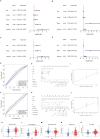

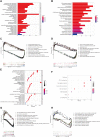
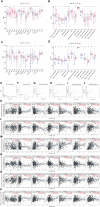
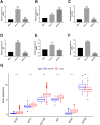
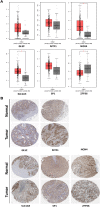
Similar articles
-
A Novel Ferroptosis-Related Gene Risk Signature for Predicting Prognosis and Immunotherapy Response in Gastric Cancer.Dis Markers. 2021 Nov 26;2021:2385406. doi: 10.1155/2021/2385406. eCollection 2021. Dis Markers. 2021. PMID: 34868391 Free PMC article.
-
Development and Validation of a Novel Ferroptosis-Related Gene Signature for Predicting Prognosis and the Immune Microenvironment in Gastric Cancer.Biomed Res Int. 2021 Oct 18;2021:6014202. doi: 10.1155/2021/6014202. eCollection 2021. Biomed Res Int. 2021. PMID: 34708125 Free PMC article.
-
Comprehensive Analysis of Ferroptosis-Related Markers for the Clinical and Biological Value in Gastric Cancer.Oxid Med Cell Longev. 2021 Oct 27;2021:7007933. doi: 10.1155/2021/7007933. eCollection 2021. Oxid Med Cell Longev. 2021. PMID: 34745421 Free PMC article.
-
A novel ferroptosis-related lncRNA signature for prognosis prediction in gastric cancer.BMC Cancer. 2021 Nov 13;21(1):1221. doi: 10.1186/s12885-021-08975-2. BMC Cancer. 2021. PMID: 34774009 Free PMC article.
-
Identification and validation of a novel ferroptosis-related gene model for predicting the prognosis of gastric cancer patients.PLoS One. 2021 Jul 12;16(7):e0254368. doi: 10.1371/journal.pone.0254368. eCollection 2021. PLoS One. 2021. PMID: 34252149 Free PMC article.
Cited by
-
Targeting Ferroptosis in Rare Neurological Disorders Including Pediatric Conditions: Innovations and Therapeutic Challenges.Biomedicines. 2025 Jan 22;13(2):265. doi: 10.3390/biomedicines13020265. Biomedicines. 2025. PMID: 40002678 Free PMC article. Review.
References
MeSH terms
Substances
Grants and funding
- No.82204641/National Outstanding Youth Science Fund Project of National Natural Science Foundation of China
- No. 2022-239/The Fifth Batch of National Traditional Chinese Medicine Excellent Clinical Talents Training Project (Announcement from the Personnel and Education Department of the National Administration of Traditional Chinese Medicine.)
- No.XPT82204641/Nanjing University of Chinese Medicine National Natural Science Foundation Young Scientists Fund Project Matching Fund Project
LinkOut - more resources
Full Text Sources
Medical
Miscellaneous

